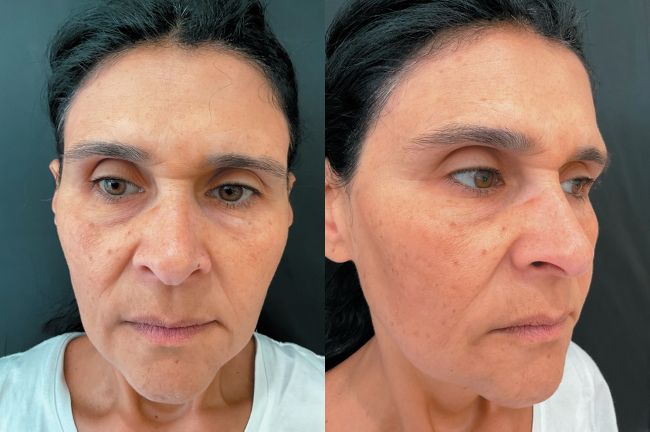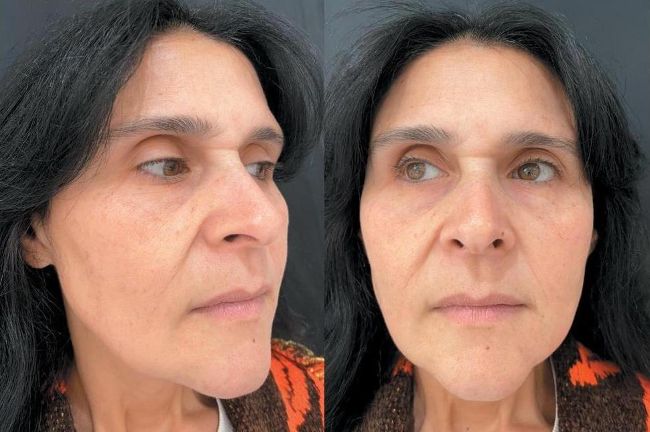CASE STUDY
TREATING HYPERPIGMENTATION WITH LASERS
Dr Hiba Injibar recounts a two-pronged laser treatment for skin damage
DR HIBA INJIBAR
DR HIBA INJIBAR
Dermasurge Clinic, based in the vibrant hub of Harley Street, stands out as a distinguished dermatology practice, founded and led by the esteemed international consultant dermatologist, Dr Hiba Injibar. With over 24 years of extensive experience in dermatology, honed through dedicated practice in the Middle East, Dr Injibar brings a wealth of expertise to London’s prestigious private medical district, specialising in medical dermatology, cosmetic dermatology, and advanced laser treatments. Driven by a vision to offer comprehensive dermatological solutions all under one roof, Dr Injibar’s goal at Dermasurge was to create a ‘one-stop-shop’ for all dermatology needs. Using cutting-edge technologies from around the globe, the clinic addresses a wide spectrum of skin concerns, ranging from cosmetic surgery needs like ageing and acne to complex conditions such as moles, scarring, vein problems, and skin cancer.
A 51-year-old female patient came to clinic with a primary concern of suninduced hyperpigmentation, specifically sun spots, as well as fine lines and an uneven skin texture. She sought treatment to rejuvenate her skin, aiming for a clearer, smoother, and more youthful complexion. Her medical history had no contraindications for laser therapy. The patient’s lifestyle included significant sun exposure in her earlier years, contributing to her current skin condition.
INITIAL ASSESSMENT
Upon clinical examination, sun spots were observed predominantly on the cheeks, forehead, and upper lip. Fine lines were most noticeable around the periocular and perioral areas, while the overall skin texture appeared slightly rough and lacked uniformity. A comprehensive evaluation determined that targeted laser treatments would be the most effective approach for addressing the patient’s concerns.
TREATMENT APPROACH
The patient underwent a two-pronged laser treatment strategy designed to address both hyperpigmentation and skin texture irregularities:
1. DEKA Q-SWITCH LASER TREATMENT
Objective: The Q-switch laser was chosen for its precision when targeting and breaking down melanin deposits responsible for the sunspots. This type of laser emits high-intensity pulses that fragment pigmented lesions without damaging surrounding skin tissue.
Procedure details: The Q-switch laser was used for one session for 10-15 minutes at a wavelength of 532 nanometres. It was used, ahead of the CO2 laser, to address the patient’s sun spots specifically. This laser zaps the sunspots in one session, as well as treating generalised pigmentation.
Post-procedure care: The patient was advised to avoid direct sun exposure and use a broad-spectrum sunscreen. Mild redness was anticipated and managed with a soothing topical cream.
2. FULL-FACE CO2 FRACTIONAL LASER TREATMENT
Objective: The fractional CO2 laser was selected to improve skin texture and reduce the appearance of fine lines by promoting collagen production and skin resurfacing. Fractional technology allows for micro-injuries that trigger the skin’s natural healing process, enhancing tissue regeneration.
Procedure details: Following the Q-switch laser treatment, Dr Injibar used the CO2 laser across the whole face to resurface the skin, address pigmentation and improve the skin’s texture and tone. This treatment takes approximately 35 minutes which also allows for numbing.
Post-procedure care: Post-treatment, redness typically lasts five to seven days. By day two, the skin develops a tan-like appearance and yellowish crust that should be wiped with a vinegar solution twice daily. Skin flaking begins around five to seven days on the face and neck. Some swelling and a sunburn feeling may occur for three to four days but are normal unless accompanied by pain or fever. Postcare instructions include staying out of direct sunlight and using a vinegar solution for cleansing. A prescribed topical antibiotic was also applied for four days and Aquaphor or Vaseline was used frequently for hydration. The patient was recommended to avoid scrubbing the treated area, use SPF 30+ sunscreen and avoid picking scabs as well as refraining from heat exposure and vigorous exercise while staying hydrated and sleeping with an elevated pillow on the first day to reduce swelling.
RESULTS AND OBSERVATIONS
Sunspots: The DEKA Q-switch laser treatment proved highly effective in resolving hyperpigmentation. By day five posttreatment, a marked lightening of sunspots was visible. By the final post-treatment assessment, the sunspots had completely faded, leaving a uniform skin tone.
Fine lines and skin texture: The CO2 fractional laser treatment demonstrated significant improvements in skin smoothness and the reduction of fine lines. By day six post-treatment, the skin appeared fresher, with visible enhancement in texture and reduced fine lines around the eyes and mouth. At the final posttreatment evaluation, the patient’s skin showed a substantial increase in smoothness, firmness, and overall radiance.
PATIENT COMMENT
“After summer, I have lots of pigmentation and uneven skin tone due to being in the sun. I am looking forward to having my laser treatment at Dermasurge and restoring a more flawless complexion. I have had multiple treatments with Dr Injibar over the years and they have always been amazing. She makes me feel very comfortable.”
CONCLUSION
The combined use of DEKA Q-switch and CO2 fractional lasers provided a comprehensive treatment approach, effectively targeting both pigmentation and textural concerns. The nonablative nature of the DEKA Q-switch ensured the safe and efficient removal of hyperpigmentation, while the fractional CO2 laser stimulated deep skin rejuvenation.
The dual-modality approach underscores the importance of tailoring treatment plans to address multiple skin concerns in ageing patients. By targeting different skin layers — the epidermis for pigmentation and the dermis for texture and fine lines — optimal outcomes were achieved. At Dermasurge Clinic, combined treatments are often recommended to achieve the patient’s desired outcome.
The case demonstrates that combining DEKA Q-switch laser treatment with full-face CO2 fractional laser therapy is effective for managing sun-induced skin damage and signs of ageing. The patient experienced full resolution of sunspots and significant improvement in skin texture and fine lines, highlighting the efficacy of this treatment plan for similar dermatological presentations.

Before

After